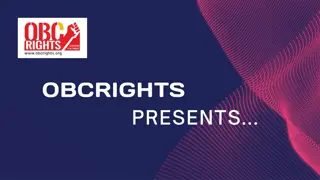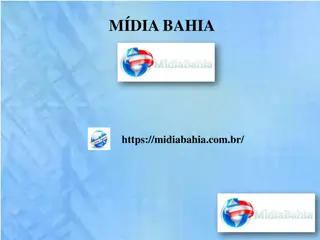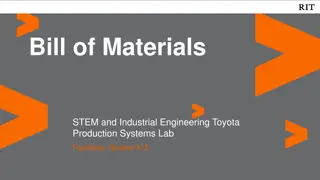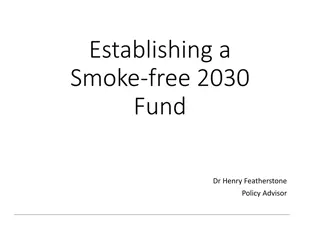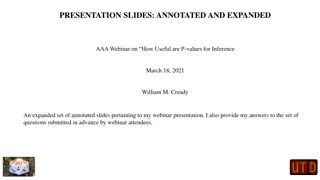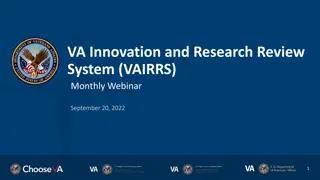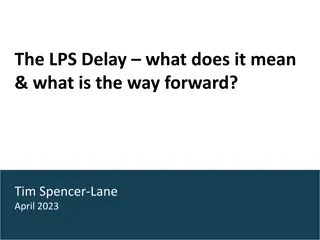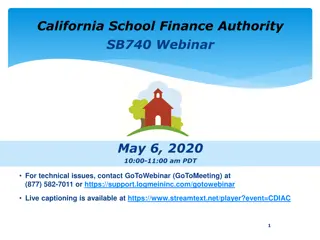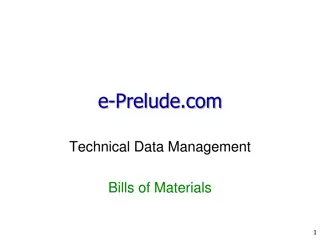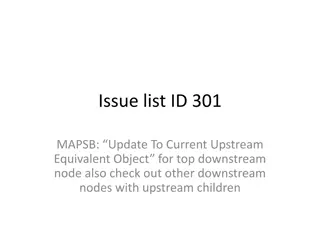
Border Operating Model Overview
"Learn about the Border Operating Model for trading with the EU post-transition period. This comprehensive document provides clarity on trading requirements, processes, and systems, guiding businesses through the stages up to July 2021. Find out what the model covers and what is excluded, including the Staged Approach due to the impact of coronavirus."
Uploaded on | 0 Views
Download Presentation

Please find below an Image/Link to download the presentation.
The content on the website is provided AS IS for your information and personal use only. It may not be sold, licensed, or shared on other websites without obtaining consent from the author. If you encounter any issues during the download, it is possible that the publisher has removed the file from their server.
You are allowed to download the files provided on this website for personal or commercial use, subject to the condition that they are used lawfully. All files are the property of their respective owners.
The content on the website is provided AS IS for your information and personal use only. It may not be sold, licensed, or shared on other websites without obtaining consent from the author.
E N D
Presentation Transcript
The Border with the European Union: Importing and exporting goods An overview of our border operating model OFFICIAL
What is the Border Operating Model? A comprehensive, consolidated document containing guidance on how to trade with the EU post transition period. Including requirements from both GB and EU Member States. Provides clarity and certainty for the border industry and businesses. Informs businesses on requirements all goods have to follow, specific requirements for controlled goods, Member State requirements and rules governing passengers. Highlights the actions that traders, hauliers, ports and carriers need to take. Covers all of the processes and systems (including those in development), across all government departments, that will be used at the end of the transition period and through the staged approach. Outlines the end to end journey for moving goods across the border - with information about controlled goods - complemented by numerous end to end journey process maps. Lays the groundwork from which the Government will move towards the world s most effective border by 2025. OFFICIAL
What is not covered in the Border Operating Model? Matters specified in the Northern Ireland Protocol To provide guidance on Northern Ireland trade, on 7 August we published moving goods under the Northern Ireland Protocol. This paper underlines our commitment to unfettered access, to minimising burdens on business, and to providing extensive support. We have set out the new Trade Support Service, which will provide an end-to-end service guiding traders through all import processes at no additional cost. This is open to traders, intermediaries and carriers moving goods into and out of Northern Ireland, backed by 200m in Government funding. We will be setting out further guidance to ensure businesses have all the information they need. OFFICIAL
Staged Approach Recognising the impact of coronavirus on businesses ability to prepare, the UK Government has taken the decision to introduce the new border controls in three stages up until 1 July 2021. This flexible and pragmatic approach will give industry extra time to make necessary arrangements. The stages are: January 2021: Traders importing non controlled goods will need to prepare for basic customs requirements. Traders will have up to six months to complete customs declarations. Safety and Security declarations will not be required on imports for the first six months. Full customs declarations will be needed for controlled goods and excise goods. Export declarations and UK exit Safety and Security declarations will be required for all goods. April 2021: All products of animal origin (POAO) and all regulated plants and plant products will also require pre-notification and the relevant health documentation. July 2021: Traders moving any goods will have to make full customs declaration at the point of importation and pay relevant tariffs. Full Safety and Security declarations will be required. Commodities subject to sanitary and phytosanitary controls must arrive at an established point of entry with an appropriate border control post. OFFICIAL
Process Maps The Border Operating Model contains a host of process maps. These are designed to show the practical application of border processes and what steps, at which stages, traders will have to undertake to transport goods across the border. Using these maps should guide traders to the requirements to move goods into and out of the country not only for core import/export processes but also for controlled goods, aviation, rail and energy.
The Goods Vehicle Movement Service (GVMS) The GVMS is an IT platform which supports the pre-lodgement model. The GVMS will allow: Declaration references to be linked together so that the person moving the goods (e.g. a haulier) only has to present one single reference (Goods Movement Reference or GMR). This can be an MRN (for goods declared into CHIEF or Customs Declaration Service or for Transit a TAD), or an EORI (for certain facilitations). The trader will be need to share this unique number with the Haulier. The linking of the movement of the goods to declarations, enabling the automatic arrival in HMRC systems as soon as goods board so that declarations can be processed en route. Notification of the risking outcome of declarations This will be done in two ways: 1. A direct link from the haulier s own system into the Goods Vehicle Movement Service; or 2. An online portal available in the haulier s Government Gateway account. For January 2021 GVMS will be introduced for transit movements only. Traders moving goods out of GB will not be required to use GVMS for transit processes. For July 2021 (stage 3), GVMS will be in place for all imports, exports and transit movements at border locations which have chosen to introduce it. This is a commercial decision that individual ports will make in due course. OFFICIAL
The Check an HGV is ready to cross the border service To ensure a smooth movement of goods at the border, the check an HGV is ready to cross the border service will be deployed. This will check that necessary documentation for exporting goods such as S&S and customs declarations have been made. If the necessary documentation has not been submitted the service will provide advice that the HGV should not proceed until they have evidence they have been submitted. This process can be done by the HGV driver, the haulage firm or even the trader. Completing the above will give the driver a Kent Access Pass (KAP) which will be a legal requirement for HGVs over 7.5 tonnes intending to travel via the Port of Dover or Eurotunnel. Failure to comply with this could result in a 300 on the spot fine. This system will help prevent large hold ups caused by HGVs without completed documentation and inform authorities which HGVs are ready to cross the border. HMG will shortly be publishing it s response to the consultation. This service is currently in beta testing. OFFICIAL
Infrastructure To support the staged model new infrastructure is required. From January these will be used to support CTC processes, ATA Carnet processes, CITES processes and traffic management processes. Some infrastructure will be inland where ports don t have the space. From July further infrastructure will be required for appropriate compliance and SPS checks which will take place at Border Control Posts (BCP). The UK government has launched a fund of 200m for ports to build these facilities with a deadline of 30 October to bid. A further 270m has been made for inland customs facilities. NB: diagram is representative of HMG sites, not a comprehensive map of all infrastructure being built OFFICIAL
Passengers From 1 January 2021, passengers travelling from GB to an EU country may purchase excise goods (alcohol and tobacco) free of excise duty and VAT. From 1 January 2021, all passengers travelling into GB will be subject to personal allowances for goods, whether these were purchased tax and duty paid or tax and duty free. Passengers exceeding these allowances can make a simple online declaration before arriving into GB or make an oral declaration at the point of import. The VAT Retail Export Scheme will end on 31 December which means that overseas visitors won t be able to obtain a VAT refund on items bought in GB and taken home in luggage. Retailers can however still send VAT free shopping to addresses outside GB. EU ID cards will be phased out as a valid travel document for entry to the UK. From 1 October 2021, EU, EEA and Swiss nationals will require a passport to travel to the UK except where their rights are protected by the Withdrawal Agreement. Provision will be made to ensure that EU, EEA and Swiss citizens may also continue to use our e-passport gates and the existing queuing arrangements. This will be kept under review. OFFICIAL
Summary of new processes This edition of the Border Operating Model: confirmed that should a trader use an intermediaries authorisation for a simplified declaration process that the intermediary will not take on liability for duties and VAT. confirmed that ports using the pre-lodgement model will have specific reasonable steps to take to discharge their liabilities. These will fall into three categories depending on the space available for checks to be undertaken. confirmed that a poor compliance history which would prevent usage of simplified declaration procedures such as delayed declarations would include evidence of recent serious non-compliance, deliberate non-compliance or a record of involvement of non-compliant businesses. HMG expects most traders will be able to delay declarations. confirmed the level of checks traders can expect on certain Sanitary and Phytosanitary (SPS) goods from 1 July 2021. New annexes on aviation, rail and energy. These cover the specific processes for bringing goods into the country via these methods and how they differ from the core import/export models for transit. OFFICIAL
What are the next steps? Future Guidance The Border Operating Model represents a comprehensive, consolidated document containing guidance on how to trade with the EU post transition period. Should there be a need we will supply further guidance for traders as it becomes available. Actions for traders Intermediaries can help traders find the information needed to complete formalities and submit the required declarations and traders should consider if they could benefit from using one. If not using an intermediary, traders should prepare to make declarations. Whether using an intermediary or making their own declarations, traders could examine rest of world trading opportunities as from July 2021 customs requirements will be similar. OFFICIAL


